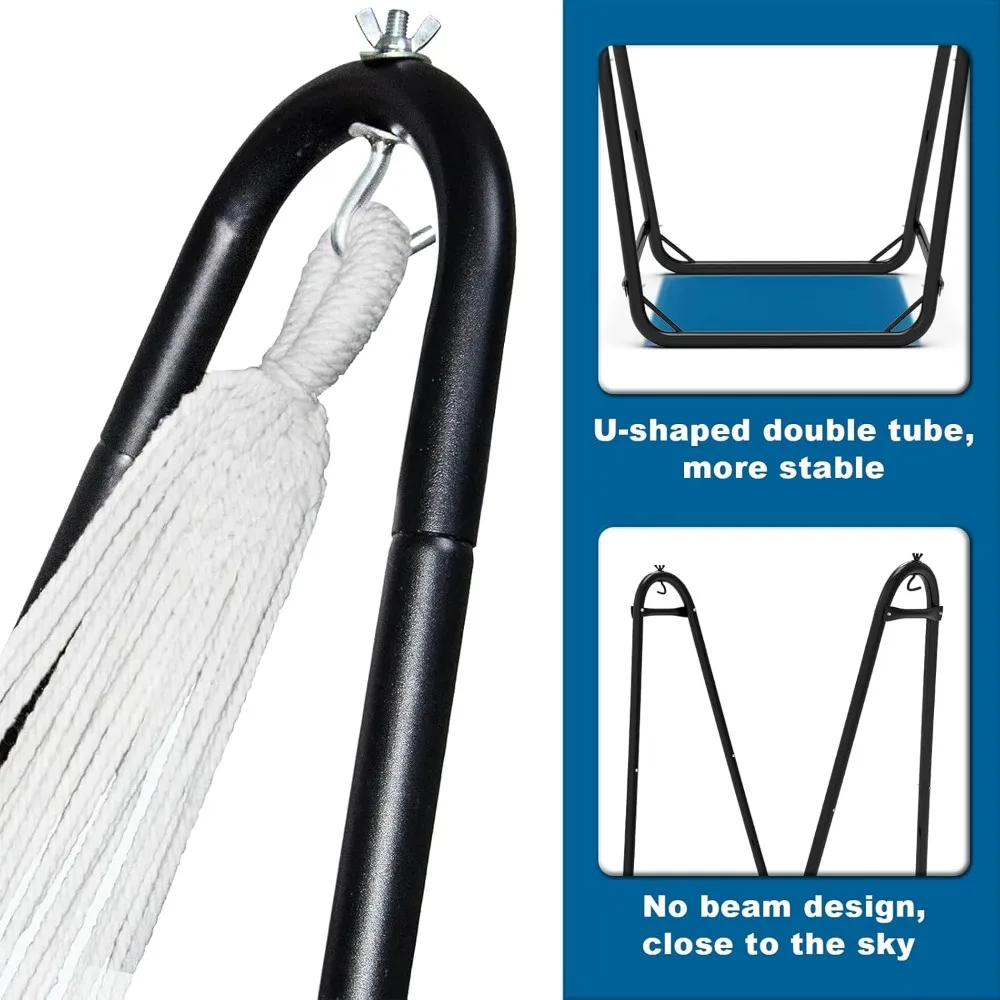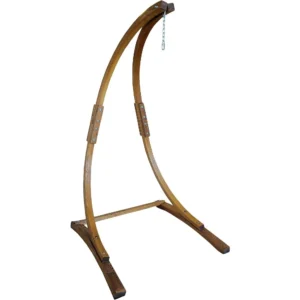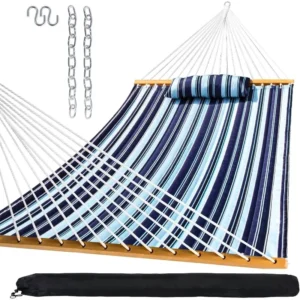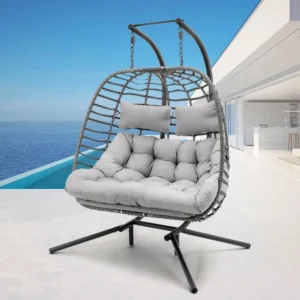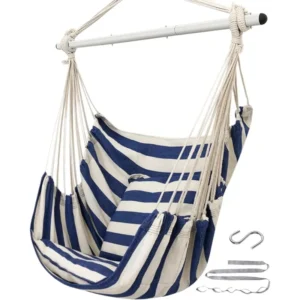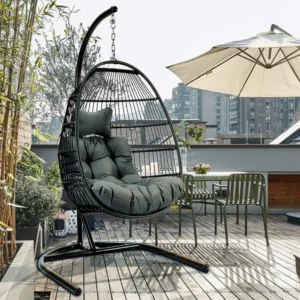A porch swing offers a perfect spot for relaxation, conversation, and enjoying the outdoors. However, many porch swings lack the comfort needed for extended enjoyment. With some thoughtful upgrades and adjustments, you can transform your basic porch swing into a luxurious retreat that beckons you to linger longer. This guide will walk you through comprehensive comfort enhancements that suit various preferences, budgets, and needs.
Understanding Your Current Porch Swing and Comfort Needs
Before diving into improvements, take time to evaluate your current porch swing and identify specific comfort issues. This assessment helps you create a targeted plan rather than making random upgrades that might not address your particular needs.
Start by sitting in your swing for at least 15 minutes and noting any discomfort:
- Does the hard seat become uncomfortable after a few minutes?
- Is there sufficient back support, or do you find yourself slouching?
- Is the swing at an appropriate height for your feet to touch the ground?
- Do the chains or ropes create pressure points or noise?
- How do you primarily use the swing (reading, napping, socializing)?
Your comfort priorities should align with how you use the swing. A reading nook might need excellent back support and good lighting, while a conversation spot requires comfortable seating for multiple people. Understanding your indoor-outdoor placement options can also affect your comfort planning, as exposure to elements influences material choices.
Common porch swing discomfort issues include hard wooden seats (particularly noticeable after 5-10 minutes of sitting), improper swing height (ideal seat height is typically 18-20 inches from the floor), inadequate back support, and exposure to direct sunlight or weather elements.
This assessment creates your “before” scenario, establishing a baseline from which you’ll build your comfort oasis.
Essential Cushions: The Foundation of Swing Comfort
The most immediate way to enhance comfort is adding proper seat cushions. These provide the foundation for all other comfort elements and make the most significant difference in how long you can comfortably enjoy your swing.
For optimal support and comfort, look for cushions with these characteristics:
- Thickness: 3-4 inches (7.5-10 cm) provides enough cushioning without raising seat height too much
- Density: Medium to firm density prevents bottoming out while still feeling soft
- Material: High-resilience foam offers the best balance of comfort and durability
When selecting cushion materials, consider these options:
- High-density polyurethane foam: Offers excellent support and durability but needs weather protection
- Quick-dry foam: Specially designed for outdoor use, drains water efficiently
- Polyester fiberfill: Softer feel but compresses over time, good for back cushions
- Memory foam: Provides customized support but retains heat in summer months
Measuring for the perfect fit is crucial. Measure your swing’s seat width, depth, and back height, then add 1-2 inches for fullness. Secure attachment is equally important—look for cushions with ties, Velcro straps, or non-slip backing to prevent sliding.
Many porch swing chair sets come with coordinated cushions designed specifically for the dimensions and contours of the swing, offering a perfectly matched foundation for your comfort oasis.
For durability in outdoor conditions, choose weather-resistant fabrics like Sunbrella, Olefin, or solution-dyed polyester. These materials resist fading, repel water, and withstand UV exposure while still feeling soft against the skin.
Back Support Solutions for Extended Lounging
While seat cushions form the comfort foundation, proper back support allows for extended relaxation sessions without strain or discomfort.
For optimal back support, consider these options:
- Full-length back cushions: Provide consistent support across the entire back
- Lumbar pillows: Target the lower back curve where support is most critical
- Contoured back cushions: Follow the natural curve of the spine for ergonomic support
- Individual back pillows: Allow customizable support for different users
Proper placement makes a significant difference in effectiveness. Position lumbar support at the natural curve of your lower back (typically 4-6 inches above the seat). Upper back support should allow a slight recline while maintaining natural spinal alignment.
For different swing designs, adapt your approach:
– Slatted backs: Use full cushions to prevent pressure points between slats
– Curved backs: Choose flexible or segmented cushions that follow the contour
– Bench-style swings: Add both back and armrest cushions for proper support
Understanding proper indoor hanging safety principles can inform how your swing should be positioned and supported for maximum comfort and security. The same principles of weight distribution and support apply to both hammocks and porch swings.
To prevent cushions from sliding, look for these secure attachment options:
– Ties that fasten around slats or frame elements
– Hook-and-loop (Velcro) strips applied to both the swing and cushion
– Non-slip backing materials on the cushion itself
– Hidden zippers for a cleaner look while maintaining adjustability
Accent Pillows: Adding Layers of Softness and Style
Once you’ve established foundational comfort with proper seat and back cushions, accent pillows add both visual appeal and functional comfort enhancements.
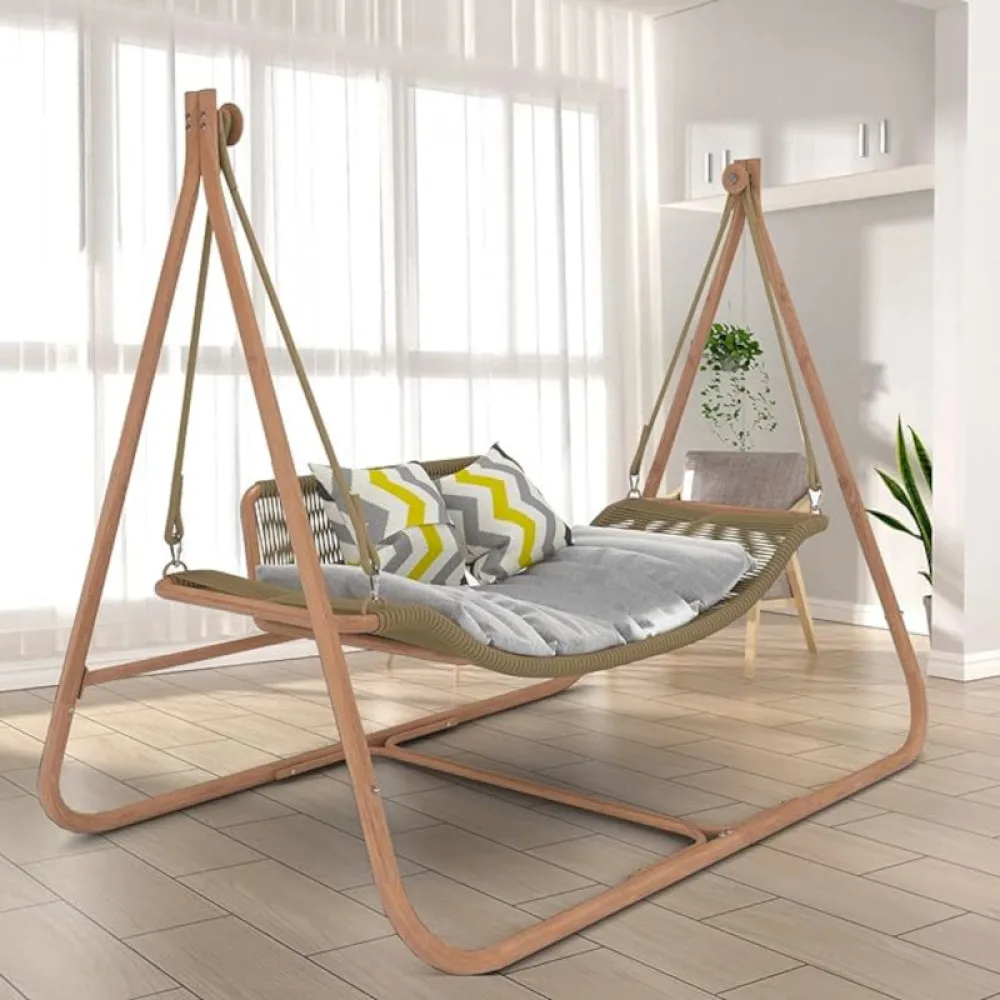
Strategically placed accent pillows serve multiple purposes:
- Arm support: Square or rectangular pillows (12-16 inches) at either end provide elbow and arm cushioning
- Neck support: Small bolster or rectangular pillows positioned at the upper back create headrest comfort
- Lower back support: Additional small pillows can enhance lumbar support for different sitting positions
- General coziness: Various sizes and shapes create an inviting, layered look
For a standard two-person porch swing, consider this combination:
– Two 18-inch square pillows for the back corners
– Two 16-inch square pillows for arm support
– One or two smaller lumbar pillows for additional back support
Many deep seat chair hammock sets showcase excellent examples of how proper pillow layering creates an inviting, comfortable seating area.
When selecting outdoor pillows, choose water-resistant fabrics with UV protection. Quick-drying polyester fills or foam cores work best for outdoor settings. Consider keeping a storage chest nearby for pillows during inclement weather to extend their life.
For visual appeal, mix textures and complementary colors while maintaining a cohesive look. A good rule is to include at least one solid color, one pattern, and one textured fabric while keeping within a consistent color palette.
Ergonomic Adjustments for Optimal Body Positioning
Beyond cushions and pillows, the physical positioning of your swing significantly impacts comfort. Making proper ergonomic adjustments ensures your body remains properly supported regardless of cushioning.
Key ergonomic considerations include:
- Swing height: Ideal seat height is 17-19 inches (43-48 cm) from the floor, allowing feet to rest comfortably on the ground
- Swing angle: A slight recline (about 5 degrees) provides optimal relaxation without making it difficult to stand up
- Chain or rope length: Should be equal on all corners for level seating; uneven suspension causes uncomfortable tilting
- Seat depth: Optimally 18-22 inches (45-56 cm), allowing back support without cutting off circulation behind knees
To test if your current swing height is correct, sit with feet flat on the ground. Your knees should form approximately a 90-degree angle. If your feet dangle, the swing is too high; if knees are higher than hips, it’s too low.
Many enthusiasts find that applying comfortable hammock setup principles to porch swings yields excellent results. Both require proper tension, appropriate height, and strategic placement for maximum comfort.
For chain or rope comfort, consider:
– Wrapping chains with soft fabric or installing chain covers to prevent pinching
– Adding rubber or silicone sleeves where chains connect to the swing to reduce noise
– Installing comfort springs between the ceiling hooks and chains to add gentle bounce
Simple adjustments to these mechanical elements can dramatically improve comfort without any additional cushioning.
DIY Comfort Upgrades for the Hands-On Homeowner
For those who enjoy projects, several DIY approaches can significantly enhance porch swing comfort while adding a personal touch.
Basic Seat Upholstery Project:
Materials needed:
– High-density foam (3 inches thick)
– Weather-resistant fabric
– Staple gun and staples
– Scissors and measuring tape
– Optional: spray adhesive
Steps:
1. Measure seat dimensions and cut foam to size
2. Cut fabric, allowing 6 inches extra on all sides
3. Center foam on fabric, wrap tightly, and secure with staples underneath
4. Fold corners neatly like wrapping a present
5. Attach to swing seat with screws or heavy-duty Velcro
No-sew options are particularly appealing for outdoor projects:
– Use outdoor fabric glue for hems and seams
– Try fusible bonding tape with an iron for clean edges
– Explore pre-made outdoor cushion covers with drawstrings or Velcro closures
When undertaking DIY modifications, always consider proper installation requirements and safety guidelines to ensure your comfort upgrades don’t compromise structural integrity.
For chain improvements:
– Wrap chains with soft rope or fabric strips
– Add decorative chain covers for both comfort and visual appeal
– Install rubber spacers where chains connect to the swing frame
These DIY projects typically cost 40-60% less than purchasing ready-made solutions while allowing complete customization to your specific comfort needs.
Functional Accessories that Enhance Relaxation
Beyond the swing itself, strategic accessories can elevate your comfort experience by addressing practical needs and creating a complete relaxation zone.
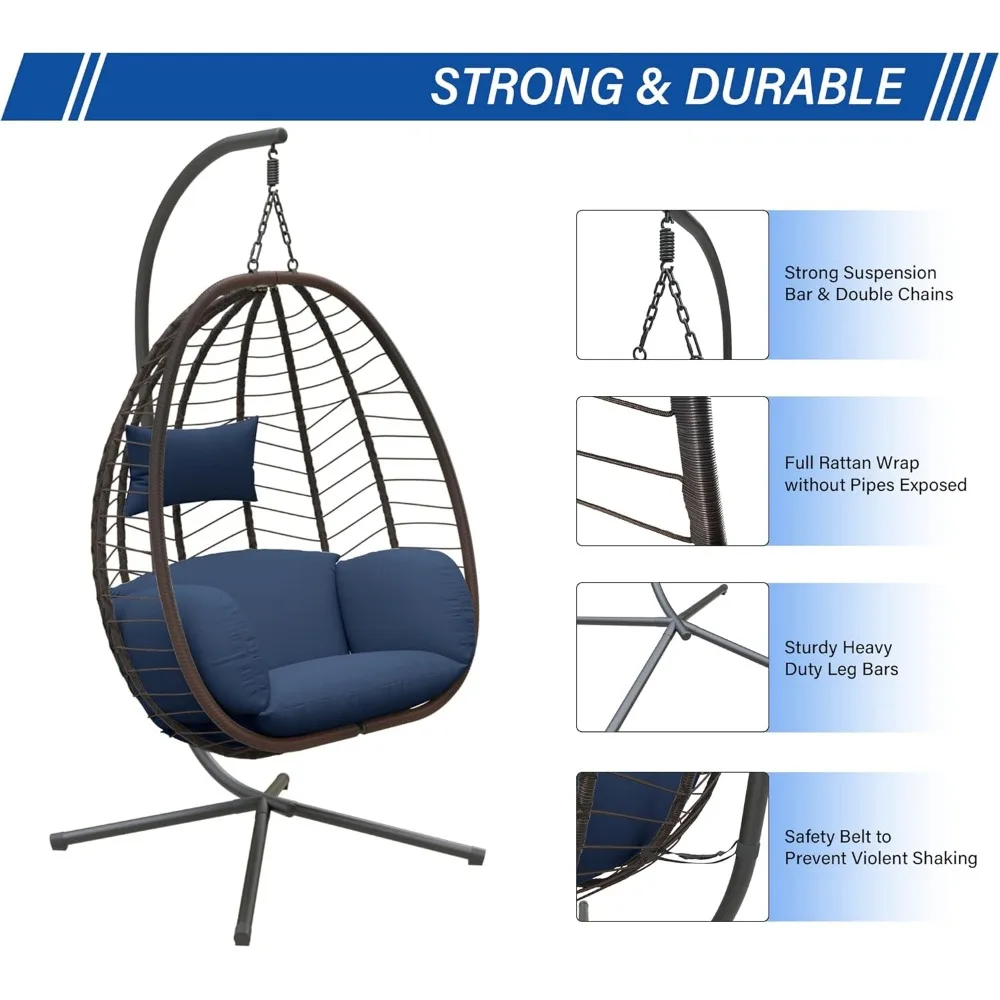
Consider these functional additions:
- Beverage holders: Side-mounted cup holders or small folding tables prevent spills and eliminate the need to get up
- Footrests or ottomans: Allow for different sitting positions and better circulation during extended lounging
- Canopies or shade solutions: Provide protection from sun and light rain, extending usable hours
- Side tables: Offer convenient surfaces for books, devices, or snacks
- Comfort springs: Add gentle bounce and reduce jarring at the end of each swing
Hammock sets with canopy features demonstrate how overhead protection enhances comfort by controlling light exposure and providing shelter from light precipitation or falling debris.
For creating a defined relaxation zone:
– Add an outdoor rug under the swing to soften the space visually and physically
– Install weather-resistant curtains that can be drawn for privacy or shade
– Consider string lights or subtle lighting for evening ambiance
– Position potted plants nearby to create a garden-like atmosphere
These accessories transform a simple swing into a purposeful retreat space, encouraging longer periods of enjoyment and relaxation.
Weather-Resistant Materials: Durability Meets Comfort
For long-lasting comfort, selecting appropriate weather-resistant materials is essential. The right materials maintain their pleasant feel while withstanding outdoor conditions.
When evaluating outdoor fabrics, consider these factors:
- UV resistance: Look for solution-dyed fabrics that won’t fade quickly
- Water resistance: Fabrics should repel water but remain breathable
- Mildew resistance: Essential for humid climates
- Comfort against skin: Some technical fabrics feel scratchy or synthetic
- Cleaning ease: Materials that can be wiped clean or machine washed
Top-performing outdoor fabrics include:
– Sunbrella (excellent UV resistance, soft feel)
– Olefin (quick-drying, colorfast)
– Solution-dyed polyester (good value, colorfast)
– PVC-coated polyester (fully waterproof but less breathable)
For cushion fill materials, consider:
– Quick-dry foam (open-cell structure allows water drainage)
– Marine-grade foam (designed specifically for wet environments)
– Polyester fiberfill with antimicrobial treatment
Climate-specific considerations are important when determining whether to leave outdoor furniture exposed. In areas with frequent rain or high humidity, prioritize quick-drying materials and consider storage options for cushions when not in use.
The most successful outdoor comfort solutions balance performance with tactile comfort—technical enough to withstand the elements but pleasant enough to enjoy against your skin.
Maintaining Your Comfortable Oasis: Care and Longevity
Creating comfort is just the beginning; maintaining it ensures your porch swing remains inviting for years to come.
Establish a regular maintenance routine:
- Weekly: Brush off debris, spot clean spills immediately
- Monthly: Deep clean cushion covers, check hardware connections
- Seasonally: Wash all fabric components, inspect for wear, tighten hardware
For cushion care:
– Follow manufacturer’s cleaning instructions precisely
– Use mild soap and water for most outdoor fabrics
– Allow to dry completely before replacing on swing
– Consider fabric protector sprays for additional stain resistance
During off-seasons or severe weather:
– Store removable cushions and pillows indoors
– Use weather-resistant covers for the entire swing if possible
– Elevate stored cushions to prevent moisture accumulation
Regular inspection prevents minor issues from becoming major problems:
– Check chains or ropes for fraying or rust
– Examine swing hardware for loosening
– Look for wood splintering or metal corrosion
Many quilted fabric hammock sets demonstrate excellent durability principles that apply equally to porch swing materials and construction, particularly in how fabrics are joined and reinforced.
With proper care, quality outdoor cushions typically last 3-5 years, while the swing structure itself can remain serviceable for decades with appropriate maintenance.
Budget-Friendly Comfort Solutions for Every Porch Swing
Creating your comfort oasis doesn’t require a massive investment. Options exist at various price points, allowing you to enhance comfort gradually or immediately depending on your budget.
Budget Level: $50-75
– DIY seat cushion using outdoor foam and fabric
– Set of weather-resistant throw pillows
– Chain covers and comfort springs
– Secondhand side table for beverages
Budget Level: $100-150
– Basic manufactured seat cushion
– Coordinating back pillows
– Small outdoor side table
– Simple overhead shade solution
Budget Level: $200+
– Complete custom cushion set
– Premium fabric with extended warranty
– Integrated canopy or shade system
– Coordinating accessories and side tables
Proper placement strategies significantly impact comfort regardless of budget. Even a modestly equipped swing feels luxurious when positioned in the right location with appropriate sun exposure and view.
For the budget-conscious, consider these approaches:
– Shop end-of-season sales for outdoor cushions (typically 40-70% off)
– Repurpose indoor cushions with outdoor fabric covers
– Start with the seat cushion (biggest comfort impact) and add elements over time
– Look for weatherproof cushions from discount home stores
Remember that comfort is subjective—prioritize the elements that address your specific discomfort issues rather than trying to implement every possible improvement.
Dark Wood Hammock Sets, Porch Swing Chair Sets
$653.82 Select options This product has multiple variants. The options may be chosen on the product pageHammock Sets with Canopy, Heavy Duty Hammock Sets
$286.31 Select options This product has multiple variants. The options may be chosen on the product page- $963.29 Select options This product has multiple variants. The options may be chosen on the product page
Deep Seat Chair Hammock Sets, Hanging Egg Chair Sets
$165.85 Select options This product has multiple variants. The options may be chosen on the product pageFolding Hammock Sets, Hanging Egg Chair Sets, Porch Swing Chair Sets, Swinging Hammock Chair Sets
$989.06 Select options This product has multiple variants. The options may be chosen on the product page
Creating Your Perfect Personalized Swing Retreat
Armed with knowledge about cushions, ergonomics, accessories, and materials, you’re ready to create your personalized porch swing retreat that reflects your comfort preferences and style sensibilities.
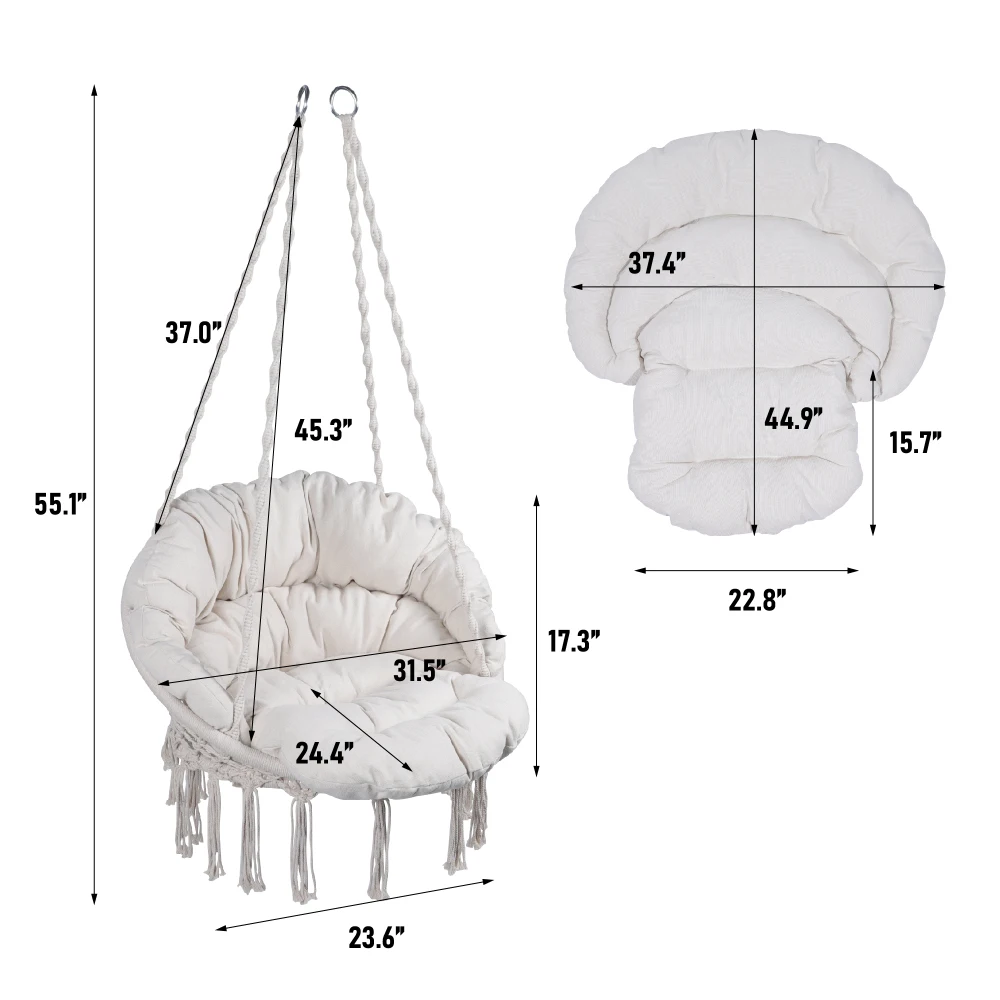
Consider how you want your swing to function:
– As a reading sanctuary with proper lighting and support
– As a conversation hub with comfortable seating for two or more
– As a napping haven with full-body support and shade
– As a meditation spot with minimalist comfort and natural views
Your personal porch swing retreat becomes more than just outdoor furniture—it transforms into a destination that draws you outdoors and encourages regular relaxation. The relaxation benefits of properly set up swings extend beyond physical comfort to provide genuine mental wellness advantages.
Start with the most impactful changes based on your initial comfort assessment, then add layers of comfort and personalization as time and budget allow. Whether through quality purchased elements or creative DIY solutions, your transformed porch swing awaits—ready to become your favorite spot for relaxation, connection, and outdoor enjoyment.

